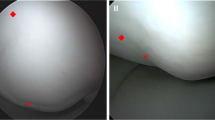Abstract
Background
The stability of an osteochondritis dissecans (OCD) lesion of the humeral capitellum may be determined by intraoperative probing with unstable lesions being displaceable. Although preoperative imaging is used to diagnose and determine treatment of these lesions, it is unclear whether unstable lesions on imaging correspond to those found intraoperatively.
Questions/Purposes
We therefore examined the concordance between preoperative imaging and intraoperative instability and examined the imaging features of the patients who healed without surgery.
Methods
We retrospectively reviewed 61 patients who underwent OCD of the humeral capitellum surgery or nonoperative treatment. All patients had plain radiography, MRI, and/or CT scans. The presence or absence of stability was determined intraoperatively by the International Cartilage Repair Society OCD classification. We determined the sensitivity, specificity, and predictive value of various imaging findings to predict instability.
Results
The following preoperative imaging features were associated with intraoperative instability: a displaced fragment, epiphyseal closure of the capitellum, or a lateral epicondyle observed on radiographs; irregular contours of the articular surface or a high signal interface on T2-weighted MRI; and a displaced fragment observed on CT. Unstable lesions were more common when the epiphysis of the capitellum was closed. Intralesional segmentation was sensitive for detecting an unstable lesion, whereas displaced type on the radiographs and displaced fragment on the CT were specific. The following imaging findings were not seen in nonoperative patients: displaced type and closure of the epiphyseal line on radiographs, irregular contours of the articular surface, articular defects, and T2 high signal intensity interface between the fragments and their bed on the MRI or a displaced fragment on the CT.
Conclusions
Although we found high sensitivity for some preoperative findings on imaging, none reached 100% of sensitivity. Preoperative MRI related to the intraoperative assessment of stability.
Level of Evidence
Level III, diagnostic study. See Guidelines for Authors for a complete description of levels of evidence.






Similar content being viewed by others
References
Brittberg M, Winalski CS. Evaluation of cartilage injuries and repair. J Bone Joint Surg Am. 2003;85(Suppl 2):58–69.
Fritz RC, Steinbach LS, Tirman PF, Martinez S. MR imaging of the elbow. An update. Radiol Clin North Am. 1997;35:117–144.
Jans LB, Ditchfield M, Anna G, Jaremko JL, Verstraete KL. MR imaging findings and MR criteria for instability in osteochondritis dissecans of the elbow in children. Eur J Radiol. 2012;81:1306–1310.
Kijowski R, Blankenbaker DG, Shinki K, Fine JP, Graf BK, De Smet AA. Juvenile versus adult osteochondritis dissecans of the knee. Radiology. 2008;248:571–578.
Kijowski R, De Smet A. Radiography of the elbow for evaluation of patients with osteochondritis dissecans of the capitellum. Skeletal Radiol. 2005;34:266–271.
Kijowski R, De Smet A. MRI findings of osteochondritis dissecans of the capitellum with surgical correlation. AJR Am J Roentgenol. 2005;185:1453–1459.
Minami M, Nakashita K, Ishii S, Usui M, Muramatsu I, Ogino T, Fukuda K, Sugawara M. [Twenty-five cases of osteochondritis dissecans of the elbow] [in Japanese]. Clin Orthop Surg. 1979;14:805–810.
Murphy BJ. MR imaging of the elbow. Radiology. 1992;184:525–529.
Takahara M, Mura N, Sasaki J, Harada M, Ogino T. Classification, treatment, and outcome of osteochondritis dissecans of the humeral capitellum. J Bone Joint Surg Am. 2007;89:1205–1214.
Takahara M, Mura N, Sasaki J, Harada M, Ogino T. Classification, treatment, and outcome of osteochondritis dissecans of the humeral capitellum. J Bone Joint Surg Am. 2008;90(Suppl 2):47–62.
Takahara M, Ogino T, Takagi M, Tsuchida H, Orui H, Nambu T. The natural progression of osteochondritis dissecans of the humeral capitellum. Radiology. 2000;216:207–212.
Takahara M, Ogino T, Tsuchida H, Takagi M, Kashiwa H, Nambu T. Sonographic assessment of osteochondritis dissecans of the humeral capitellum. AJR Am J Roentgenol. 2000;174:411–415.
Van den Ende KI, McIntosh AL, Adams JE, Steinmann SP. Osteochondritis dissecans of the capitellum: a review of the literature and a distal ulnar portal. Arthroscopy. 2011;27:122–128.
Acknowledgments
We thank Dr Hitoshi Ishikawa, Department of Health Information Management, Yamagata Saisei Hospital, for his assistance and support.
Author information
Authors and Affiliations
Corresponding author
Additional information
Each author certifies that he or she, or a member of his or her immediate family, has no funding or commercial associations (eg, consultancies, stock ownership, equity interest, patent/licensing arrangements, etc) that might pose a conflict of interest in connection with the submitted article.
All ICMJE Conflict of Interest Forms for authors and Clinical Orthopaedics and Related Research editors and board members are on file with the publication and can be viewed on request.
Each author certifies that his or her institution approved the human protocol for this investigation, that all investigations were conducted in conformity with ethical principles of research, and that informed consent for participation in the study was obtained.
About this article
Cite this article
Satake, H., Takahara, M., Harada, M. et al. Preoperative Imaging Criteria for Unstable Osteochondritis Dissecans of the Capitellum. Clin Orthop Relat Res 471, 1137–1143 (2013). https://doi.org/10.1007/s11999-012-2462-9
Published:
Issue Date:
DOI: https://doi.org/10.1007/s11999-012-2462-9




